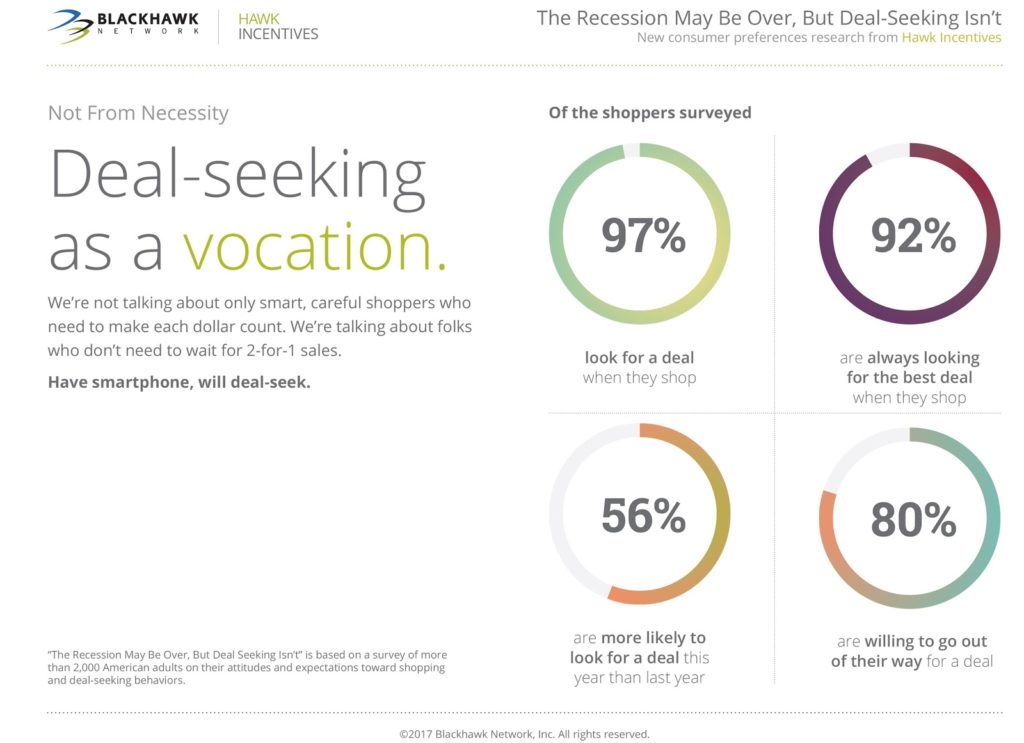A marketing manager’s guide to coupon affiliate success.
We saw during the 2008 recession that affiliate marketing is very important when an economy swings down because consumer behaviors change and traffic to online coupon sites increase.
Even if you already have a solid network of influencers promoting your brand, there is more you can do right now to reach the right customers.
97% of US consumers say they look for deals when they shop, and 92% say they are “always” looking for deals, according to a recent survey.
Surprisingly, deal-seeking behavior is not limited to those who need to stick to a budget. In fact, 86% of respondents looking for deals reported annual household earnings of at least $200,000.

If you’re wondering how coupons will fit into your marketing mix or are concerned about coupons diminishing brand perception, read JEBCommerce in-depth study to discover the truth about coupon affiliates.
When you’re ready to build a coupon affiliate program this market manager’s guide will get you started in a big way.
How do Coupon Affiliate Sites Work?
Coupon sites come in many different shapes and sizes from the traditional coupon sites you’re familiar with, to cash back sites like Rakuten (previously Ebates) and browser extensions like Honey.
From an advertiser’s standpoint one of the most appealing aspects of affiliate marketing is the minimal up-front cost and low-risk.
Unlike traditional advertising, you do not pay for impressions or clicks that may or may not turn into sales, you only pay a commission on completed sales.
Because your sales partners have significant flexibility in how they promote you they will require more oversight. You’ll most likely start by hiring an affiliate management company, like JEBCommerce. They will act as a channel between you and the coupon website, leveraging current relationships to maximize your exposure!
An affiliate management agency, or OPM, identifies the best sales partners for your niche, negotiates the best real estate, gets you exclusive offers and deals and negotiates all the terms of your partnership including commission rates.
Best thing is they handle any and all issues of bad coupons being used, coupons from other channels being promoted and creative and text link optimization.
For shoppers, coupon sites are extremely easy to use. They simply click “Redeem Now” and go straight to your checkout to purchase.
Keep reading to learn our “secret sauce” for setting ecommerce brands up for success.
3 Simple Rules for Working with Coupon Sites:
- Brand Alignment: If a coupon is posted that helps convert a sale, does this match with your company’s strategy?
- Added Value: Does this coupon site already have a loyal audience that could bring unique traffic to your site?
- Relationships: Is this site willing to have a healthy relationship?
Brand Alignment:
If we bring coupon publishers into the program, does this align with a company’s brand DNA and sales strategy?
Not always. If your brand is known as being top tier, or if an item being on sale would turn away your target consumer base – don’t add coupon publishers into your program. It’s that easy!
Coupon sites aren’t a fit for every brand, and it’s important for the advertiser and agency to have a clear alignment on this stance. If, however, your product attracts a consumer who is looking for a lowered price and is often discounted to attract them … you have a match!
Added Value:
How is added value defined? Well, if a coupon partner comes into your program, what benefit will they bring your program that was unavailable prior to bringing them in? Usually this means a new audience, placement options that will expose your brand to someone who might not have been exposed (and is a fit to be a potential consumer), and a way to convert new sales!
Get to know your partners well, and if this new site will BENEFIT your program … add them! A great tip to know whether or not this site will bring value, is to look at all competitive offers listed. Is the category fiddle with useful and dated content? If so, that’s a good sign!
Relationships:
A coupon site is like any affiliate partner. You should hear from them often, have a human contact and be able to reach out if any updates are needed on their site.
Are they friendly and help represent your brand? Great! Sometimes we see partners in the space that might have a small audience base, and use illegal term bidding to compete against larger brands such as RetailMeNot.
If this practice is against your program terms, be careful of these sites! But if you have a responsive contact, any issues should be easily solved through a phone call or email … great relationships are a beautiful thing!
Not to mention, when you want a sale posted or changed on a dime, you know who to call.
Working with Coupon Affiliates: the secret sauce
Finally, here is the “secret sauce” we train our management teams with to help decide if they should add or decline a coupon site.
Is the site fully developed and functional?
You’d be surprised at the amount of coupon sites who are working to attract new brands, but have huge development issues. When picking a partner, functionality is non-negotiable. Be cautious to look into multiple layers of a website to determine this, not just the homepage.
Does this site have a healthy amount of traffic?
Look to add a site with at least 3,000 + monthly unique visits. One of the values a coupon pub brings to a program is a loyal audience who is already visiting their site to find reliable discounts. If this doesn’t exist yet, this partner might not be ready to partner with a brand you represent. (Pro Tip: SEM Rush, VStat, Google and Similar Web are all your friends!)
Content
You want partners that consistently update their content, have lots of it, and are willing to make sure they represent your brand in a way you’re comfortable with. All affiliate partners in an affiliate program, MUST match your brand’s DNA and guidelines.
Coupon sites can be very beneficial to an affiliate program. The more sites spreading the word about your brand – the better! Especially if they’re driving quality and converting consumers who might not have otherwise been exposed to your product.


